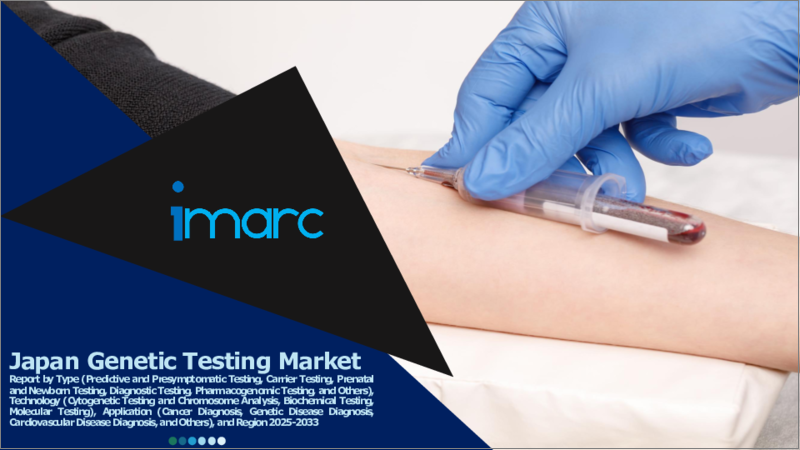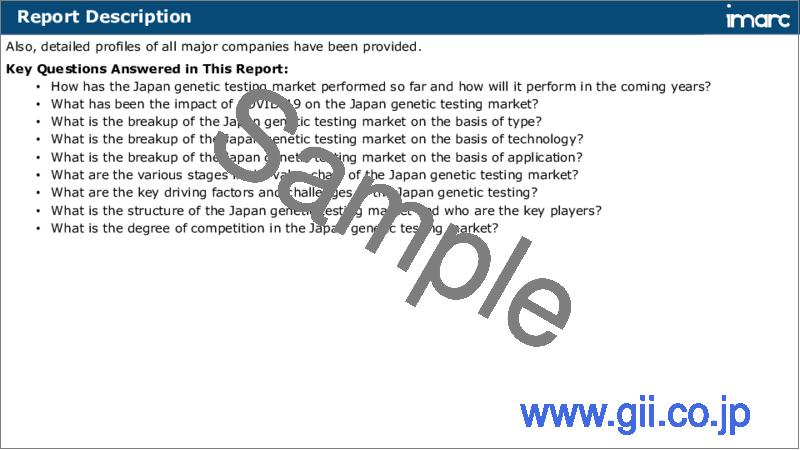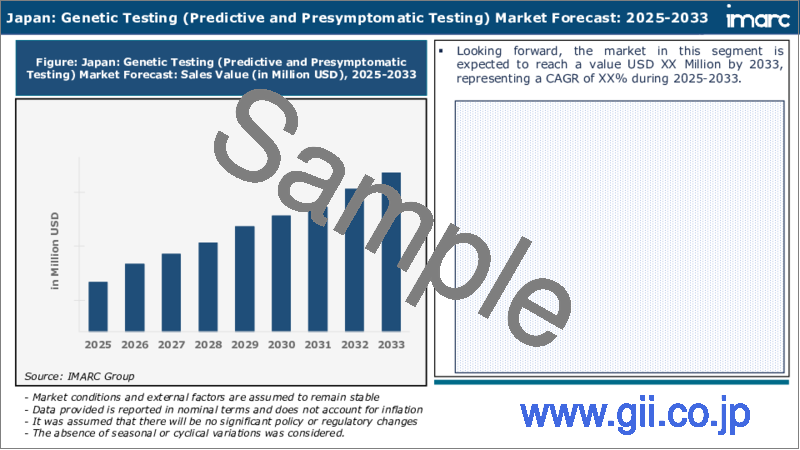|
|
市場調査レポート
商品コード
1729296
日本の遺伝子検査市場レポート :タイプ、技術、用途、地域別、2025年~2033年Japan Genetic Testing Market Report by Type, Technology, Application, and Region 2025-2033 |
||||||
カスタマイズ可能
|
|||||||
| 日本の遺伝子検査市場レポート :タイプ、技術、用途、地域別、2025年~2033年 |
|
出版日: 2025年05月01日
発行: IMARC
ページ情報: 英文 118 Pages
納期: 5~7営業日
|
- 全表示
- 概要
- 目次
日本の遺伝子検査の市場規模は2024年に8億3,850万米ドルに達しました。今後、IMARC Groupは、市場は2033年までに21億4,720万米ドルに達し、2025年から2033年の間に10.17%の成長率(CAGR)を示すと予測しています。情報に基づいたヘルスケアの意思決定のための遺伝的洞察の採用が増加していることが、主に市場成長の原動力となっています。
本レポートで扱う主な質問
- 日本の遺伝子検査市場はこれまでどのように推移し、今後どのように推移するのか?
- COVID-19が日本の遺伝子検査市場に与えた影響は?
- 日本の遺伝子検査市場のタイプ別区分は?
- 日本の遺伝子検査市場の技術別区分は?
- 日本の遺伝子検査市場の用途別区分は?
- 日本の遺伝子検査市場のバリューチェーンにおける様々なステージとは?
- 日本の遺伝子検査の主な促進要因と課題は何か?
- 日本の遺伝子検査市場の構造と主要プレーヤーは?
- 日本の遺伝子検査市場における競合の程度は?
目次
第1章 序文
第2章 調査範囲と調査手法
- 調査の目的
- ステークホルダー
- データソース
- 市場推定
- 調査手法
第3章 エグゼクティブサマリー
第4章 日本の遺伝子検査市場:イントロダクション
- 概要
- 市場力学
- 業界動向
- 競合情報
第5章 日本の遺伝子検査市場情勢
- 過去および現在の市場動向(2019~2024年)
- 市場予測(2025~2033年)
第6章 日本の遺伝子検査市場:タイプ別内訳
- 予測的および発症前検査
- キャリアテスト
- 出生前検査および新生児検査
- 診断検査
- 薬理ゲノム検査
- その他
第7章 日本の遺伝子検査市場:技術別内訳
- 細胞遺伝学的検査と染色体分析
- 生化学検査
- 分子検査
第8章 日本の遺伝子検査市場:用途別内訳
- がん診断
- 遺伝性疾患の診断
- 心血管疾患の診断
- その他
第9章 日本の遺伝子検査市場:競合情勢
- 概要
- 市場構造
- 市場企業のポジショニング
- 主要成功戦略
- 競合ダッシュボード
- 企業評価象限
第10章 主要企業のプロファイル
第11章 日本の遺伝子検査市場: 業界分析
- 促進要因、抑制要因、機会
- ポーターのファイブフォース分析
- バリューチェーン分析
第12章 付録
Japan genetic testing market size reached USD 838.5 Million in 2024. Looking forward, IMARC Group expects the market to reach USD 2,147.2 Million by 2033, exhibiting a growth rate (CAGR) of 10.17% during 2025-2033. The growing adoption of genetic insights for informed healthcare decisions is primarily driving the market growth.
Genetic testing is a scientific method used to analyze an individual's DNA to uncover specific information about their genetic makeup and heritage. This process involves the examination of genes, chromosomes, and DNA sequences to identify variations, mutations, or markers associated with various traits, conditions, or diseases. Genetic testing can serve multiple purposes, including assessing the risk of inherited disorders, determining carrier status for specific genetic conditions, identifying ancestral origins, and aiding in personalized medical treatments and interventions. It provides valuable insights into an individual's genetic predisposition, allowing for informed decisions related to healthcare, family planning, and lifestyle choices. Additionally, genetic testing has significant implications in the fields of medical research, genealogy, and forensics, contributing to our understanding of human genetics and its diverse applications in various domains. Consequently, it is gaining extensive traction across Japan.
Japan Genetic Testing Market Trends:
The genetic testing market in Japan is experiencing notable growth and transformation, reflecting the country's advancements in healthcare and technology. In addition to this, Japan's healthcare industry, renowned for its emphasis on innovation and precision medicine, has propelled the demand for genetic testing services, which is positively influencing the regional market. Genetic testing has gained prominence in diagnosing and managing various genetic conditions and hereditary diseases, aligning with the nation's aging population and healthcare needs. Additionally, Japan's focus on cutting-edge biotechnology and research has fostered the development of advanced genetic testing techniques and expanded the range of applications, from disease risk assessment to pharmacogenomics. Apart from this, extensive investments in R&D activities are acting as significant growth-inducing factors. Moreover, the growing awareness of personalized medicine and genetic insights for informed healthcare decisions has further fueled market expansion. As Japan continues to invest in healthcare infrastructure and research, the genetic testing market is poised for continued growth and innovation in the years to come.
Japan Genetic Testing Market Segmentation:
Type Insights:
- Predictive and Presymptomatic Testing
- Carrier Testing
- Prenatal and Newborn Testing
- Diagnostic Testing
- Pharmacogenomic Testing
- Others
Technology Insights:
- Cytogenetic Testing and Chromosome Analysis
- Biochemical Testing
- Molecular Testing
- DNA Sequencing
- Others
Application Insights:
- Cancer Diagnosis
- Genetic Disease Diagnosis
- Cardiovascular Disease Diagnosis
- Others
Competitive Landscape:
The market research report has also provided a comprehensive analysis of the competitive landscape in the market. Competitive analysis such as market structure, key player positioning, top winning strategies, competitive dashboard, and company evaluation quadrant has been covered in the report. Also, detailed profiles of all major companies have been provided.
Key Questions Answered in This Report:
- How has the Japan genetic testing market performed so far and how will it perform in the coming years?
- What has been the impact of COVID-19 on the Japan genetic testing market?
- What is the breakup of the Japan genetic testing market on the basis of type?
- What is the breakup of the Japan genetic testing market on the basis of technology?
- What is the breakup of the Japan genetic testing market on the basis of application?
- What are the various stages in the value chain of the Japan genetic testing market?
- What are the key driving factors and challenges in the Japan genetic testing?
- What is the structure of the Japan genetic testing market and who are the key players?
- What is the degree of competition in the Japan genetic testing market?
Table of Contents
1 Preface
2 Scope and Methodology
- 2.1 Objectives of the Study
- 2.2 Stakeholders
- 2.3 Data Sources
- 2.3.1 Primary Sources
- 2.3.2 Secondary Sources
- 2.4 Market Estimation
- 2.4.1 Bottom-Up Approach
- 2.4.2 Top-Down Approach
- 2.5 Forecasting Methodology
3 Executive Summary
4 Japan Genetic Testing Market - Introduction
- 4.1 Overview
- 4.2 Market Dynamics
- 4.3 Industry Trends
- 4.4 Competitive Intelligence
5 Japan Genetic Testing Market Landscape
- 5.1 Historical and Current Market Trends (2019-2024)
- 5.2 Market Forecast (2025-2033)
6 Japan Genetic Testing Market - Breakup by Type
- 6.1 Predictive and Presymptomatic Testing
- 6.1.1 Overview
- 6.1.2 Historical and Current Market Trends (2019-2024)
- 6.1.3 Market Forecast (2025-2033)
- 6.2 Carrier Testing
- 6.2.1 Overview
- 6.2.2 Historical and Current Market Trends (2019-2024)
- 6.2.3 Market Forecast (2025-2033)
- 6.3 Prenatal and Newborn Testing
- 6.3.1 Overview
- 6.3.2 Historical and Current Market Trends (2019-2024)
- 6.3.3 Market Forecast (2025-2033)
- 6.4 Diagnostic Testing
- 6.4.1 Overview
- 6.4.2 Historical and Current Market Trends (2019-2024)
- 6.4.3 Market Forecast (2025-2033)
- 6.5 Pharmacogenomic Testing
- 6.5.1 Overview
- 6.5.2 Historical and Current Market Trends (2019-2024)
- 6.5.3 Market Forecast (2025-2033)
- 6.6 Others
- 6.6.1 Historical and Current Market Trends (2019-2024)
- 6.6.2 Market Forecast (2025-2033)
7 Japan Genetic Testing Market - Breakup by Technology
- 7.1 Cytogenetic Testing and Chromosome Analysis
- 7.1.1 Overview
- 7.1.2 Historical and Current Market Trends (2019-2024)
- 7.1.3 Market Forecast (2025-2033)
- 7.2 Biochemical Testing
- 7.2.1 Overview
- 7.2.2 Historical and Current Market Trends (2019-2024)
- 7.2.3 Market Forecast (2025-2033)
- 7.3 Molecular Testing
- 7.3.1 Overview
- 7.3.2 Historical and Current Market Trends (2019-2024)
- 7.3.3 Market Segmentation
- 7.3.3.1 DNA Sequencing
- 7.3.3.2 Others
- 7.3.4 Market Forecast (2025-2033)
8 Japan Genetic Testing Market - Breakup by Application
- 8.1 Cancer Diagnosis
- 8.1.1 Overview
- 8.1.2 Historical and Current Market Trends (2019-2024)
- 8.1.3 Market Forecast (2025-2033)
- 8.2 Genetic Disease Diagnosis
- 8.2.1 Overview
- 8.2.2 Historical and Current Market Trends (2019-2024)
- 8.2.3 Market Forecast (2025-2033)
- 8.3 Cardiovascular Disease Diagnosis
- 8.3.1 Overview
- 8.3.2 Historical and Current Market Trends (2019-2024)
- 8.3.3 Market Forecast (2025-2033)
- 8.4 Others
- 8.4.1 Historical and Current Market Trends (2019-2024)
- 8.4.2 Market Forecast (2025-2033)
9 Japan Genetic Testing Market - Competitive Landscape
- 9.1 Overview
- 9.2 Market Structure
- 9.3 Market Player Positioning
- 9.4 Top Winning Strategies
- 9.5 Competitive Dashboard
- 9.6 Company Evaluation Quadrant
10 Profiles of Key Players
- 10.1 Company A
- 10.1.1 Business Overview
- 10.1.2 Services Offered
- 10.1.3 Business Strategies
- 10.1.4 SWOT Analysis
- 10.1.5 Major News and Events
- 10.2 Company B
- 10.2.1 Business Overview
- 10.2.2 Services Offered
- 10.2.3 Business Strategies
- 10.2.4 SWOT Analysis
- 10.2.5 Major News and Events
- 10.3 Company C
- 10.3.1 Business Overview
- 10.3.2 Services Offered
- 10.3.3 Business Strategies
- 10.3.4 SWOT Analysis
- 10.3.5 Major News and Events
- 10.4 Company D
- 10.4.1 Business Overview
- 10.4.2 Services Offered
- 10.4.3 Business Strategies
- 10.4.4 SWOT Analysis
- 10.4.5 Major News and Events
- 10.5 Company E
- 10.5.1 Business Overview
- 10.5.2 Services Offered
- 10.5.3 Business Strategies
- 10.5.4 SWOT Analysis
- 10.5.5 Major News and Events
11 Japan Genetic Testing Market - Industry Analysis
- 11.1 Drivers, Restraints and Opportunities
- 11.1.1 Overview
- 11.1.2 Drivers
- 11.1.3 Restraints
- 11.1.4 Opportunities
- 11.2 Porters Five Forces Analysis
- 11.2.1 Overview
- 11.2.2 Bargaining Power of Buyers
- 11.2.3 Bargaining Power of Suppliers
- 11.2.4 Degree of Competition
- 11.2.5 Threat of New Entrants
- 11.2.6 Threat of Substitutes
- 11.3 Value Chain Analysis






